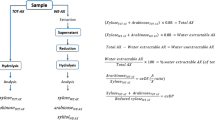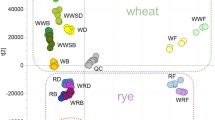Abstract
Arabinoxylans (AX) consumption has been related to the treatment and prevention of cardiovascular diseases, type II diabetes, colorectal cancer and obesity. The beneficial health effects are conferred through gut microbiota modulation, and therefore, they have been proposed as potential slowly fermentable prebiotic candidates. As the mechanisms are not yet well understood, the prebiotic potential of AX from brewer’s spent grain (BSG) has been investigated. Two types of AX from BSG (AX1 and AX2) of different length and branching averages were fermented with human faecal inocula and compared to fermented cultures containing a commercial prebiotic (fructooligosaccharide (FOS)) and cultures with no added carbohydrate (control). Results demonstrated that the AX were extensively metabolised after 48 h of fermentation. The pH decreased along fermentation and the lowest value was achieved in AX1 cultures. The production of short chain fatty acids (SCFA) was higher in AX cultures than in cultures containing FOS and controls, with AX1 presenting the highest concentrations. The stimulatory effect of beneficial bacteria was higher in AX cultures, and AX2 presented the highest positive effect. Prebiotic potential of AX from BSG was confirmed by the production of SCFA and the modulation of gut microbiota, especially by the high increase in bifidobacteria populations.


Similar content being viewed by others
References
Broekaert WF, Courtin CM, Verbeke K, Van de Wiele T, Verstraete W, Delcour JA (2011) Prebiotic and other health-related effects of cereal-derived arabinoxylans, arabinoxylan-oligosaccharides, and xylooligosaccharides. Crit Rev Food Sci Nutr 51:178–194
Charalampopoulos D, Wang R, Pandiella SS, Webb C (2002) Application of cereals and cereal components in functional foods: a review. Int J Food Microbiol 79:131–141
Cloetens L, Broekaert WF, Delaedt Y, Ollevier F, Courtin CM, Delcour JA, Rutgeerts P, Verbeke K (2010) Tolerance of arabinoxylan-oligosaccharides and their prebiotic activity in healthy subjects: a randomised, placebo-controlled cross-over study. Br J Nutr 103:703–713
Figueroa-González I, Quijano G, Ramírez G, Cruz-Guerrero A (2011) Probiotics and prebiotics—perspectives and challenges. J Sci Food Agric 91:1341–1348
Grootaert C, Delcour JA, Courtin CM, Broekaert WF, Verstraete W, Van de Wiele T (2007) Microbial metabolism and prebiotic potency of arabinoxylan oligosaccharides in the human intestine. Trends Food Sci Technol 18:64–71
Gullón B, Gullón P, Sanz Y, Alonso JL, Parajó JC (2011a) Prebiotic potential of a refined product containing pectic oligosaccharides. LWT–Food Sci Technol 44:1687–1696
Gullón P, González-Muñoz MJ, Parajó JC (2011b) Manufacture and prebiotic potential of oligosaccharides derived from industrial solid wastes. Bioresour Technol 102:6112–6119
Gullón B, Gullón P, Tavaria F, Pintado M, Gomes AM, Alonso JL, Parajó JC (2014) Structural features and assessment of prebiotic activity of refined arabinoxylooligosaccharides from wheat bran. J Funct Foods 6:438–449
Hague A, Elder DJE, Hicks DJ, Paraskeva C (1995) Apoptosis in colorectal tumour cells: induction by the short chain fatty acids butyrate, propionate and acetate and by the bile salt deoxycholate. Int J Cancer 60:400–406
Hartemink R, Schoustra SE, Rombouts FM (1999) Degradation of guar gum by intestinal bacteria. Biosci Microflora J 18:17–25
Holzapfel WH, Schillinger U (2002) Introduction to pre- and probiotics. Food Res Int 35:109–116
Hopkins MJ, Englyst HN, Macfarlane S, Furrie E, Macfarlane GT, McBain AJ (2003) Degradation of cross-linked and non-cross-linked arabinoxylans by the intestinal microbiota in children. Appl Environ Microbiol 69:6354–6360
Hughes SA, Shewry PR, Li L, Gibson GR, Sanz ML, Rastall RA (2007) In vitro fermentation by human fecal microflora of wheat arabinoxylans. J Agric Food Chem 55:4589–4595
Hughes SA, Shewry PR, Gibson GR, McCleary BV, Rastall RA (2008) In vitro fermentation of oat and barley derived β-glucans by human faecal microbiota. FEMS Microbiol Ecol 64:482–493
Jaskari J, Kontula P, Siitonen A, Jousimies-Somer H, Mattila-Sandholm T, Poutanen K (1998) Oat β-glucan and xylan hydrolysates as selective substrates for Bifidobacterium and Lactobacillus strains. Appl Microbiol Biotechnol 49:175–181
Kabel MA, Kortenoeven L, Schols HA, Voragen AGJ (2002) In vitro fermentability of differently substituted xylo-oligosaccharides. J Agric Food Chem 50:6205–6210
Mussatto SI, Dragone G, Roberto IC (2006) Brewers’ spent grain: generation, characteristics and potential applications. J Cereal Sci 43:1–14
Napolitano A, Costabile A, Martin-Pelaez S, Vitaglione P, Klinder A, Gibson GR, Fogliano V (2009) Potential prebiotic activity of oligosaccharides obtained by enzymatic conversion of durum wheat insoluble dietary fibre into soluble dietary fibre. Nutr Metab Cardiovasc Dis 19:283–290
Nawirska A, Kwasniewska M (2005) Dietary fibre fractions from fruit and vegetable processing waste. Food Chem 91:221–225
Neyrinck AM, Possemiers S, Druart C, Van de Wiele T, De Backer F, Cani PD, Larondelle Y, Delzenne NM (2011) Prebiotic effects of wheat arabinoxylan related to the increase in Bifidobacteria, Roseburia and Bacteroides/Prevotella in diet-induced obese mice. PLoS One 6:e20944
Ovreås L, Forney L, Daae FL, Torsvik V (1997) Distribution of bacterioplankton in meromictic Lake Saelenvannet, as determined by denaturing gradient gel electrophoresis of PCR-amplified gene fragments coding for 16S rRNA. Appl Environ Microbiol 63:3367–3373
Pastell H, Westermann P, Meyer AS, Tuomainen P, Tenkanen M (2009) In vitro fermentation of arabinoxylan-derived carbohydrates by Bifidobacteria and mixed fecal microbiota. J Agric Food Chem 57:8598–8606
Rinttilä T, Kassinen A, Malinen E, Krogius L, Palva A (2004) Development of an extensive set of 16S rDNA-targeted primers for quantification of pathogenic and indigenous bacteria in faecal samples by real-time PCR. J Appl Microbiol 97:1166–1177
Roberfroid M (2007) Prebiotics: the concept revisited. J Nutr 137:830S–837S
Rose DJ, Patterson JA, Hamaker BR (2009) Structural differences among alkali-soluble arabinoxylans from maize (Zea mays), rice (Oryza sativa), and wheat (Triticum aestivum) brans influence human fecal fermentation profiles. J Agric Food Chem 58:493–499
Salazar N, Gueimonde M, Hernández-Barranco AM, Ruas-Madiedo P, de los Reyes-Gavilán CG (2008) Exopolysaccharides produced by intestinal Bifidobacterium strains act as fermentable substrates for human intestinal bacteria. Appl Environ Microbiol 74:4737–4745
Topping DL, Clifton PM (2001) Short-chain fatty acids and human colonic function: roles of resistant starch and nonstarch polysaccharides. Physiol Rev 81:1031–1064
Van den Abbeele P, Gérard P, Rabot S, Bruneau A, El Aidy S, Derrien M, Kleerebezem M, Zoetendal EG, Smidt H, Verstraete W, Van de Wiele T, Possemiers S (2011) Arabinoxylans and inulin differentially modulate the mucosal and luminal gut microbiota and mucin-degradation in humanized rats. Environ Microbiol 13:2667–2680
Vardakou M, Palop CN, Christakopoulos P, Faulds CB, Gasson MA, Narbad A (2008) Evaluation of the prebiotic properties of wheat arabinoxylan fractions and induction of hydrolase activity in gut microflora. Int J Food Microbiol 123:166–170
Voragen AGJ (1998) Technological aspects of functional food-related carbohydrates. Trends Food Sci Technol 9:328–335
Acknowledgments
The authors wish to acknowledge the Irish Department of Agriculture, Food and the Marine for their funding of this project (No. 08RDTAFRC665) under the Food Institutional Research Measure (FIRM). B. Gullón and P. Gullón are grateful to Fundação para a Ciência e Tecnologia (FCT) for the postdoctoral fellowships references SFRH/BPD/79941/2011 and SFRH/BPD/79942/2011. S. Ferreira was supported by FCT with the fellowship reference SFRH/BD/66857/2009 and co-financed by Fundo Social Europeu (FSE). Authors are also grateful to Xunta de Galicia for the financial support of this work (INBIOMED project), partially funded by FEDER “Unha maneira de facer Europa”.
Author information
Authors and Affiliations
Corresponding author
Rights and permissions
About this article
Cite this article
Reis, S.F., Gullón, B., Gullón, P. et al. Evaluation of the prebiotic potential of arabinoxylans from brewer’s spent grain. Appl Microbiol Biotechnol 98, 9365–9373 (2014). https://doi.org/10.1007/s00253-014-6009-8
Received:
Revised:
Accepted:
Published:
Issue Date:
DOI: https://doi.org/10.1007/s00253-014-6009-8




